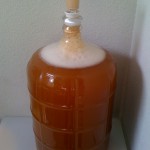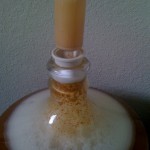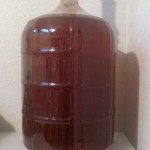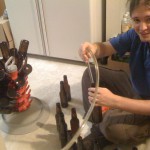Brew #1 – Hefeweizen
5/24/2011 – Brew Day
2 lb – German pilsner malt
1 lb – Red wheat
5 lb – Wheat extract
1 oz – Hallertau hop pellets (60 min)
Fermented with White labs Hefeweizen ale yeast WLP300
Grains soaked a bit too hot (160 – 165 degrees) for about 25 minutes. Down to 150 degrees for the last 20 minutes. Cooled by packing ice around the brew pot. Racked into primary (bucket). Gravity: 1.041 (79 degrees). Shaken to oxygenate.
5/27/2011 – Rack to Secondary
Moved early (since I was going out of town) and the airlock got clogged on its first night in the secondary (5gal carboy).
6/7/2011 – Capped 9 bottles
Used Coopers Carb Drops instead of priming sugar. Originally added too much sugar (2 drops per bottle) to most of the bottles. Racked back to secondary to allow excess sugars to ferment out. No clamps for the racking cane and the bottling wand, so lots of oxygen introduced. Gravity: 1.004 (76 degrees) 4.9%
6/12/2011 – Capped remaining 43 bottles
Still no clamps on the racking cane, but Eric’s iron grip reduced air leaks most of the time. 1 Carb Drop per bottle this time.
Some notes on Hefeweizen from the web:
Hefes do not require a secondary.
After a week of fermentation, take a hydrometer reading and record it. In two or three days, take another hydrometer reading and record it. If the two readings are the same you can bottle it. If they are different, wait two or three more days, take another reading and record it. When you get two readings that are the same, you can bottle it.
They should be left for two to three weeks to carbonate, although discrete testing may indicate an earlier time, if they carbonate faster.
They will often become completely clear after bottling, something we didn’t expect. Apparently, it is standard to swirl the bottle halfway through pouring to pull the yeast back into solution, as the yeast provides much of the traditional character of the beer. If drinking from the bottle, roll it on its side gently for a bit and/or turn it upside down a couple times before opening.
They tend to be perfectly drinkable quite young and do not keep super well for long periods of time. So plan to drink up!



